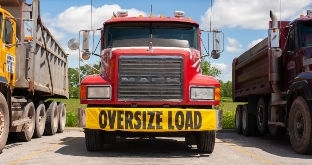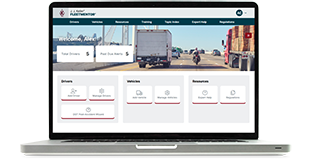Transport Safety Editor — J. J. Keller & Associates, Inc.
Oversize Loads: How Big is Too Big?
Avoiding a citation for an overweight load starts with understanding the limits, and that's not as simple as it sounds. Learn more about managing oversize loads.
Published On: 11/01/2024


Written by:
Corrina Peterson
Avoiding a citation for an overweight load starts with understanding the limits, and that’s not as simple as it sounds.
There are two primary limiters of vehicle weight:
- Rated gross value, and
- Allowed gross value.
These two limits are not only applied to the vehicle; they are also applied to axle groups, axles, and tires.
The ratings are set by the manufacturer of the vehicle and by the manufacturers of the components. The allowed weights are set, regulated, and enforced by federal, state, and local government agencies.
Maximum may never be met
Usually, the maximum gross weight allowed will be the state’s maximum allowed gross. Be careful though, because unless the load is perfectly balanced across the axles and groups, the maximum is rarely met due to one of the other limits being reached first. These limits include:
- The allowed axle weight(s) based on the state or local statutes,
- The allowed axle group weight based on the bridge law (each combination of axles and distance is determined separately),
- The allowed weight per tire or inch of tire width,
- Each tire’s rating, and
- The registered vehicle weight.
Different roads, different limits, permits required
The Federal Highway Administration (FHWA) sets weights that the state must allow on interstate highways, including:
- Maximum gross vehicle weight at 80,000 pounds,
- Maximum gross weight upon any one axle at 20,000 pounds, and
- Maximum gross weight on tandem axles at 34,000 pounds.
States can set their own limits, which can be higher or lower, on state and other highways.
When a vehicle or load is nondivisible, the FHWA allows the states to issue special permits. The permit process and the weights allowed by them can be as varied as the states themselves. Permits may, in addition to an increase in the approved gross vehicle weight or gross combination weight, provide increases to the allowed axle and group weights.
To avoid citations, remember to consider:
- All the vehicle’s component weight ratings, and
- The allowances for the local, state, and federal roads on which the vehicle operates.
The larger the area of operation, the more difficult the compliance task is, but also the more important. Use the FleetMentor Permit Advisor to check your route and get a quick summary of the federal and jurisdictional permits you will need to operate and transport a specific shipment.
Not a FleetMentor user? Start your 30-Day Free Trial today!
Order your oversize/overweight permit at www.kellerpermits.com.

J. J. Keller® FleetMentor® Service
The J. J. Keller® FleetMentor® System serves and supports thousands of transportation professionals every day with problem-solving tools and guidance. Whether you have one truck or a thousand, a fleet of commercial motor vehicles or F-150s, or haul goods or provide services — FleetMentor has you covered.
You may also enjoy the following articles:
Sign up for our newsletter!
We'll help you stay on top of regulations, best practices, and fleet industry news. Sign up to receive a monthly email notification with links to our most recent blog articles, free resources, and event invites.